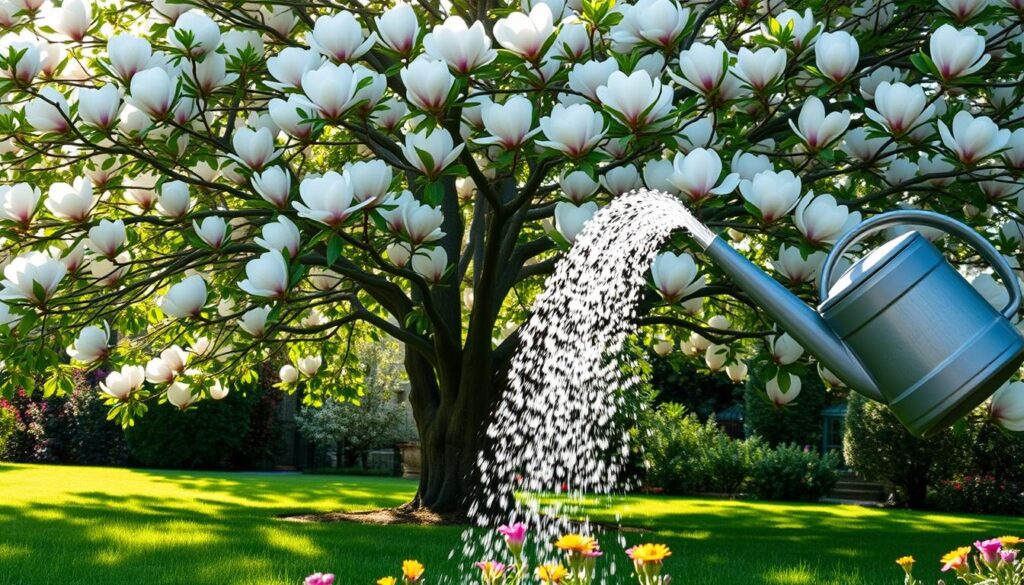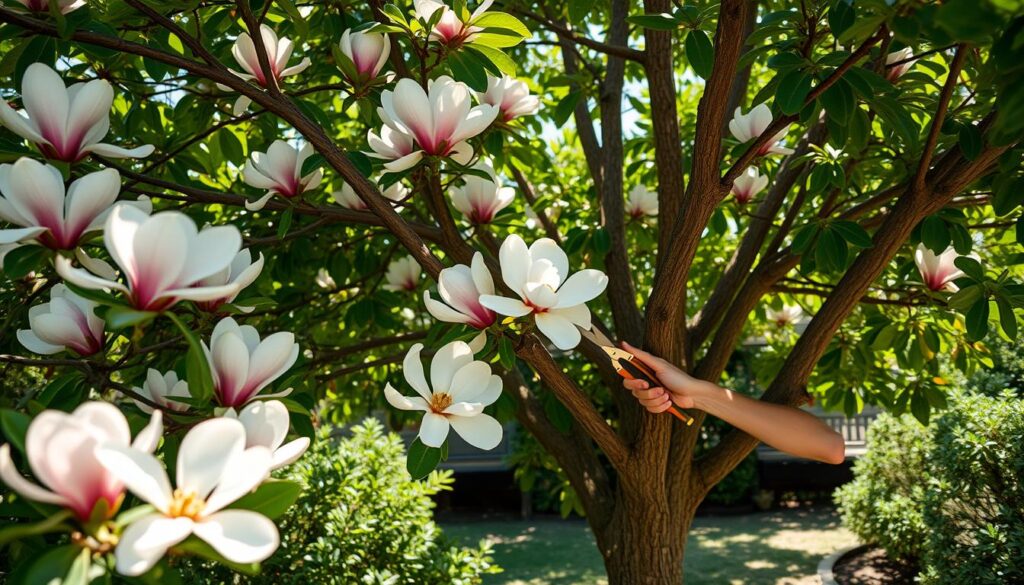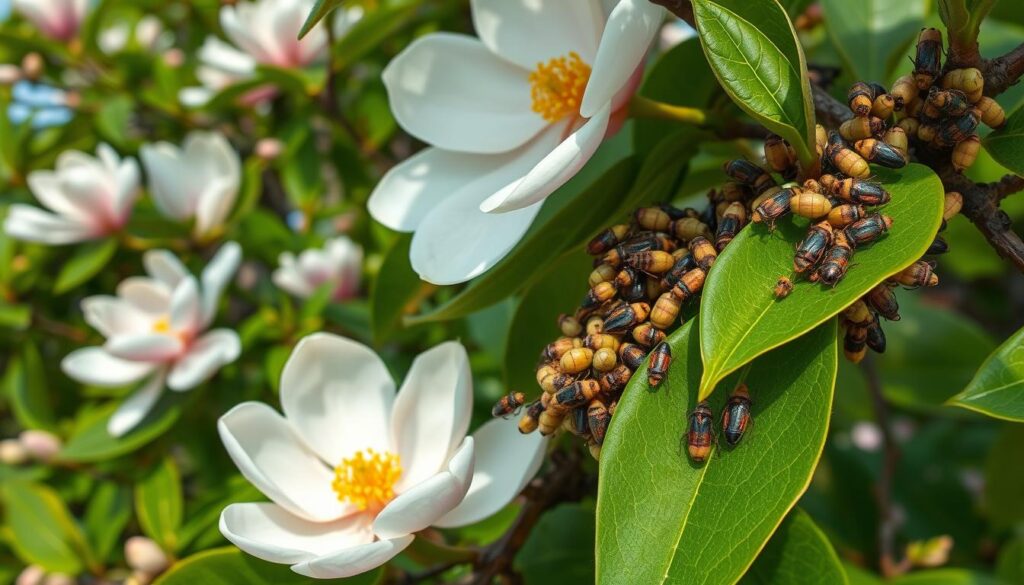A magnolia tree not thriving worries many gardeners. Knowing how to care for it is key to its survival. By focusing on soil, water, and sunlight, you can help your tree flourish. Regular care is also vital to avoid diseases like leaf spot and blight.
Watering, fertilizing, and pruning are essential for a healthy magnolia. Regular fertilizing in March and September supports growth. It also prevents too many leaves from falling off. Watering right is also important. Too much water can rot the roots, while too little can turn leaves brown.
Table of Contents
Key Takeaways
- Proper magnolia care is essential for the tree’s survival and thriving.
- Adequate watering, fertilization, and pruning are key for a healthy magnolia tree.
- Regular fertilizing helps prevent leaf drop and supports growth.
- Consistent watering is necessary to avoid root rot and brown leaves.
- Magnolia trees need specific care, including soil and sunlight, to thrive.
- Understanding magnolia care helps gardeners create the best conditions for their tree.
- Following proper care techniques allows gardeners to enjoy their magnolia’s beauty and prevent diseases.
Understanding the Magnolia Tree’s Needs
Magnolia tree care is all about giving the tree what it needs to thrive. This means knowing the best soil, how much water it needs, and how much sunlight it should get. By doing this, gardeners can help their magnolia trees grow strong and healthy.
For soil conditions, magnolia trees do best in well-draining soil that’s slightly acidic. This kind of soil helps the roots breathe and get the nutrients they need. When it comes to watering requirements, these trees need steady moisture, most in the first year after planting. How often to water depends on the weather, but a good rule is to water young trees two to three times a week.
Ideal Soil Conditions
The perfect soil for magnolia trees includes:
- Fertile, acidic soil with a pH between 5.5 and 6.5
- Well-draining soil to prevent waterlogged roots
- A mix of organic matter, such as compost or manure, to enrich the soil
Watering Requirements
The amount of water a magnolia tree needs changes with the climate and the tree’s age. Here are some basic guidelines:
- Young trees: water two to three times a week during the first year
- Established trees: water once a week during the growing season
- Water deeply, providing about 2-3 gallons of water per inch of trunk diameter
By knowing what a magnolia tree needs, gardeners can create the perfect environment for it to thrive. This means taking care of the soil, watering, and sunlight. With the right care, magnolia trees can bloom beautifully and add beauty to any landscape.
| Tree Age | Watering Frequency | Water Amount |
|---|---|---|
| Young (0-1 year) | 2-3 times a week | 2-3 gallons per inch of trunk diameter |
| Established (1-2 years) | 1 time a week | 2-3 gallons per inch of trunk diameter |
| Mature (2+ years) | As needed | 2-3 gallons per inch of trunk diameter |
Common Signs Your Magnolia Tree Is Struggling
Magnolia tree problems can be spotted by looking at the tree’s health and looks. A common sign is yellowing leaves, which might mean the tree needs more nutrients or has too much water. Another sign is stunted growth, which could be from not enough food or pruning.
Some problems with magnolia trees are not so obvious and need a closer look. For example, unusual leaf drop might mean pests, diseases, or stress from the environment. Spotting these signs early can help gardeners fix their trees and stop more damage.
To fix magnolia tree problems, knowing what causes them is key. Here are some common issues:
- Yellowing leaves due to nutrient deficiencies or overwatering
- Stunted growth caused by inadequate fertilization or pruning
- Unusual leaf drop resulting from pests, diseases, or environmental stressors
By finding and fixing these problems, gardeners can help their magnolia trees grow strong and enjoy their flowers for many years.
| Magnolia Tree Problem | Cause | Solution |
|---|---|---|
| Yellowing Leaves | Nutrient deficiencies or overwatering | Adjust fertilization or watering schedule |
| Stunted Growth | Inadequate fertilization or pruning | Adjust fertilization or pruning schedule |
| Unusual Leaf Drop | Pests, diseases, or environmental stressors | Identify and address underlying cause |
Environmental Factors Affecting Your Magnolia
Environmental factors greatly impact the health and growth of magnolia trees. The magnolia tree environment is shaped by climate and pests. Knowing these factors helps create a good space for your magnolia tree to flourish.
Climate is key, as it affects how well the tree grows. Deciduous magnolias are more prone to pests than evergreen ones. Evergreen magnolias, though, are more sensitive to changes in temperature and humidity.
Important factors in the magnolia tree environment include:
- Pest impact: Watch for pests during the growing season to catch them early.
- Climate considerations: Knowing the best climate for your magnolia helps create a good environment.
- Urban vs. rural planting: Where you plant your magnolia affects its exposure to pollutants and pests.
By considering these factors, you can make a great environment for your magnolia tree. Always check your tree’s health and adjust its care to ensure it grows well and blooms beautifully.
| Environmental Factor | Impact on Magnolia Tree |
|---|---|
| Climate Considerations | Affects hardiness and growth rate |
| Pest Impact | Can lead to leaf yellowing, premature leaf drop, and branch dieback |
| Urban vs. Rural Planting | Affects exposure to pollutants, pests, and diseases |
Effective Watering Techniques for Magnolia Trees
Proper magnolia tree watering is key for their growth and survival. To water your magnolia tree right, learn about deep watering and how to avoid overwatering. When planting a new magnolia, deep watering is best. Water for 5 seconds per gallon of the nursery pot size.
A well-drained, slightly acidic soil is best for magnolia trees. Here are some watering tips for your magnolia tree:
- Water your magnolia tree 1-2 times a week for the first 6 months after planting to establish roots.
- For established magnolia trees, watering frequency during winter is about once every three weeks, only if there hasn’t been rainfall or snowfall.
- Avoid overwatering, which can lead to root rot and other problems.
Regularly check your magnolia tree during weekly watering to watch for issues. By following these magnolia tree watering tips and avoiding overwatering, your tree will thrive. You’ll enjoy its beautiful blooms for years.

| Season | Watering Frequency |
|---|---|
| Spring | 1-2 times a week |
| Summer | 2-3 times a week |
| Winter | Once every 3 weeks |
Soil Management for Healthy Magnolias
Soil management is key for growing healthy magnolia trees. The right soil conditions are vital for the tree’s growth. Magnolias do best in slightly acidic soil, with a pH between 5.5 and 7.0.
Importance of pH Levels
The pH level of the soil impacts nutrient availability. If the soil is too alkaline or acidic, it can cause nutrient deficiencies. This can harm the tree’s growth and health.
Regular soil testing can help determine the pH level of the soil and identify any nutrient deficiencies.
Amending Nutrient Deficiencies
To promote healthy growth, it’s important to amend nutrient deficiencies. Adding compost or well-rotted manure to the soil helps. Also, choose a balanced fertilizer that meets the tree’s nutritional needs.
Mulching Benefits
Mulching is also vital for magnolia trees. It helps retain moisture, regulate soil temperature, and suppress weeds. The benefits of mulching include:
- Retaining moisture
- Regulating soil temperature
- Suppressing weeds
By following these tips and maintaining the right soil conditions, your magnolia tree will thrive. You’ll enjoy its beautiful flowers and foliage for years.
| Soil pH Range | Optimal Nutrient Availability |
|---|---|
| 5.5-7.0 | High |
| Below 5.5 | Low |
| Above 7.0 | Low |
Pruning Practices to Encourage Growth
Pruning is key for magnolia tree growth and health. Magnolia tree pruning is best in late winter to early spring. This time is before new growth starts.
For pruning techniques, clean cuts are important. Remove dead or diseased branches to avoid damage and disease. The right pruning tools make the job easier. Sharp shears and loppers are best for cutting.
Here are some tips for successful pruning:
- Prune during the dormant season to minimize stress
- Make clean cuts to prevent damage and disease
- Use the right pruning tools for the job

Follow these tips and use the right pruning techniques and pruning tools. This will help your magnolia tree grow well and stay beautiful. Always think about your tree’s health and prune carefully to avoid harm.
| Pruning Time | Pruning Tips |
|---|---|
| Late Winter to Early Spring | Prune during the dormant season to minimize stress |
| After New Growth | Avoid pruning immediately after new growth to prevent depleting the plant’s stored energy |
Fertilizing Your Magnolia Tree
Fertilizing a magnolia tree is key for its growth. The best time is in early spring or fall, around March or September. Choose a balanced, slow-release fertilizer with nitrogen, phosphorus, and potassium.
It’s important not to over-fertilize. This can harm the tree. Follow the recommended amounts and times for application. For example, use 2 lbs or 2 pints of granular fertilizer per 100 square feet. Liquid fertilizers, like Miracle Gro, should be applied 3 to 4 times a year from late April to mid-July.
Best Fertilizers for Magnolia Trees
- Balanced, slow-release fertilizers
- High-nitrogen fertilizers, such as 20-20-20, for lush green foliage
- Organic fertilizers, such as compost or well-rotted manure
Timing Your Fertilization
The best time to fertilize magnolia trees is in early spring or fall. This helps the tree grow strong and healthy.
| Fertilizer Type | Application Rate | Frequency |
|---|---|---|
| Granular Fertilizers | 2 lbs or 2 pints per 100 square feet | Once a year |
| Liquid Fertilizers | Follow manufacturer’s instructions | 3-4 times a year |
Protecting Your Magnolia from Pests
Magnolia trees can face problems from pests like aphids, whiteflies, and spider mites. These magnolia tree pests can harm the tree, making it weaker and more prone to diseases.
To keep your magnolia tree safe, mix natural pest control with chemical treatments. Natural methods include bringing in helpful insects and using neem oil to keep pests away.
Chemical options like insecticidal soaps and horticultural oils can also work. But, use them carefully and follow the instructions for how and when to apply them.
Some common pests that harm magnolia trees include:
- Aphids: can stunt growth and reduce flowering
- Whiteflies: can lead to weakened trees by reducing photosynthesis
- Spider mites: can cause significant damage to magnolia trees by impacting photosynthesis

Watching your tree closely and acting fast is important. By combining natural and chemical methods, you can keep your magnolia tree healthy and strong.
| Pest | Damage | Control Method |
|---|---|---|
| Aphids | Stunted growth, reduced flowering | Introduce beneficial insects, use neem oil |
| Whiteflies | Weakened trees, reduced photosynthesis | Use insecticidal soaps, horticultural oils |
| Spider mites | Significant damage, reduced vigor | Use neem oil, introduce beneficial insects |
Seasonal Care Tips for Magnolia Trees
Magnolia tree care is key to their health and growth. Each season requires specific care to prevent damage and promote growth. In spring, spring care like fertilizing and pruning is vital. It helps the tree bounce back from winter.
In summer, summer maintenance is critical to avoid stress from heat and drought. Regular watering, mulching, and support are essential. Also, watch for pests and diseases and act fast if you find any.
As seasons change, so should your care routine. By following these magnolia tree seasonal care tips, your tree will thrive. You’ll enjoy its stunning flowers and foliage for many years.
| Season | Care Tips |
|---|---|
| Spring | Fertilization, pruning, monitoring for pests and diseases |
| Summer | Regular watering, mulching, providing support for the tree |
| Fall and Winter | Protecting the tree from frost, reducing watering, applying a layer of mulch |
Nurturing a Thriving Magnolia Tree
Cultivating a thriving magnolia tree is a labor of love. It needs patience, dedication, and a willingness to learn. Magnolias take time to establish their roots and reach their full height.
A standard southern magnolia can take 8 to 10 years to bloom. This shows how important it is to be patient.
The rewards of nurturing a magnolia tree are huge. Seeing it grow and bloom is amazing. Each magnolia’s journey is unique and worth celebrating.
Patience Is Key
As gardeners start caring for their magnolia trees, patience is key. With the right care, magnolias can overcome challenges and thrive. They reward their caretakers with beauty and fragrance.
By embracing the process and learning from setbacks, gardeners can enjoy their magnolia trees’ growth and resilience.
Frequently Asked Questions
How do you help a struggling magnolia tree?
First, check the basics—water, soil, and sunlight. Magnolias need well-draining soil, consistent moisture (but not soggy roots), and 6+ hours of sunlight daily. If your tree looks weak, add organic mulch around the base to retain moisture and improve soil quality. Prune dead or diseased branches and apply a balanced fertilizer in spring. If pests or fungal infections are present, treat them with horticultural oil or fungicide.
Why does my magnolia tree look like it’s dying?
Common reasons include poor drainage, drought stress, fungal infections, pests, or nutrient deficiencies. Yellow or brown leaves, dropping foliage, or weak branches may signal an issue. Check the soil moisture—too much or too little water can be harmful. Also, inspect for scale insects, root rot, or leaf spot diseases that may be affecting the tree’s health.
Why does my magnolia tree not grow?
Slow or stunted growth can be due to poor soil conditions, lack of nutrients, root damage, or not enough sunlight. If the soil is compacted, aerate it and add organic compost. Fertilize in early spring with a slow-release, low-nitrogen fertilizer. If your tree is young, be patient—some magnolia species take time to establish before showing noticeable growth.
What does a sick magnolia tree look like?
A sick magnolia may have yellowing, browning, or spotted leaves, sparse foliage, and weak or dying branches. Other signs include bark damage, black sooty mold, or sticky residue, which can indicate a pest problem like magnolia scale. If root rot is present, the tree may lean, and the lower trunk may feel soft or show decay.
Does Epsom salt help magnolia trees?
Epsom salt can help if your magnolia has a magnesium deficiency, which can cause yellowing leaves. Dissolve 1–2 tablespoons of Epsom salt per gallon of water and apply it around the base of the tree once a month. However, don’t overuse it—too much can throw off the soil’s nutrient balance.
Why is my magnolia tree thinning out?
Thinning foliage can be a sign of stress from drought, overwatering, disease, or poor soil conditions. If the tree is dropping a lot of leaves, check for scale insects or fungal diseases. Environmental stress, such as extreme heat or cold, can also cause leaf loss. Regular watering, mulching, and occasional fertilization can help restore healthy growth.

